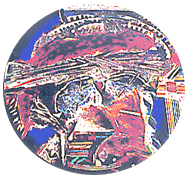...Best of Sicily
presents... Best of Sicily Magazine. ... Dedicated to Sicilian art, culture, history, people, places and all things Sicilian. |
by Carlo Trabia | ||
Magazine Best of Sicily Arts & Culture Fashion Food & Wine History & Culture About Us Travel Faqs Contact Map of Sicily |
In most countries, this kind of modification, based on artistic whim, ceased to be a serious social force by the 1980s. Even allowing for delayed reaction and effect in Sicily, it is surprising that such a proposal could have been taken very seriously in a place that boasts a great historical and artistic heritage. Few of Sicily's medieval churches were built in the pure Gothic style encountered in northern and central Europe, or even northern Italy. (Messina's crumbling church of Saint Mary of the Germans is an exception.) Instead, most are structurally Romanesque. The mosaics in some Sicilian churches are an element typical of the Eastern (Orthodox) church, where coloured windows still are not very fashionable. Even the Renaissance failed to make coloured windows popular in Italy. When these have been added to existing (Baroque) churches, including Saint Peter's in Rome, they have usually been discreet, or at least traditional, in design. Had that been the case at Cefalù, visitors would express less amazement. The emergence of abstract artistic movements during the twentieth century may be seen as a legitimate cultural and social development, but few abstract expressionists sought to modify pre-existing works of art. When did any of them seriously suggest repainting the Mona Lisa? At best, they may have reworked a photograph or printed image of Da Vinci's masterpiece, but the curator of the Louvre would not have permitted them to touch the original. Viewed as a work of art, why should a medieval cathedral be any different? Italian revisionists point to architectural "evolution" such as the architectural modification, in a less enlightened era, of medieval Romanesque churches into Baroque ones. Unfortunate though it may have been, this was part of a widespread artistic, and even philosophical, movement in certain parts of Europe. In recent times, the stucco and plaster of some of these churches has been removed to reveal their medieval magnificence (the Magione and Saint Francis of Assisi in Palermo come to mind). The idea is that an architectural work should be viewed as it was conceived by its designers. That's what millions of visitors come to Cefalù each year to see. Until now, Cefalù Cathedral has been subjected to few alterations. In Italy, many artists and architects suffer from narrow-minded perspectives, or outright misconceptions, fostered by their lack of exposure to outside influences. Many travel, but few speak other languages (especially English) which would facilitate a more profound knowledge of the world and its complex history. It is impossible to consider Sicily's multicultural heritage without knowing something of the civilisations that brought it to Sicily, and this is where many Sicilian historians fail. In the case of Cefalù Cathedral, preservation necessitates familiarity with the medieval societies of Normandy, Greece and northern Africa, as well as Italy. Abstract art just isn't part of the picture. A work of art, even when it's a church, should be allowed to speak for itself. With these newest "additions," Cefalù Cathedral is being deprived of that opportunity. The scarlet beast has reared its ugly heads. About the Author: Architect Carlo Trabia has written for various magazines and professional journals. | |
Top of Page |
 "I saw a woman sitting on a scarlet beast that was covered with
blasphemous names and had seven heads and ten horns." (Revelation 17:3)
This Biblical inspiration for the stained glass window entitled "The
Seven Heads" (shown here) is an appropriate allusion to the lack of
reverence implied in the newest addition to Cefalù's splendid twelfth
century cathedral. "Addition" to a medieval structure? Yes, the
folks responsible for the preservation of architectural and cultural assets
in Sicily decided, some years ago, that the addition of coloured windows
bearing abstract designs would enhance this Romanesque-Gothic structure
built in the Norman-Arab tradition with Byzantine (Greek) influences, appropriating
taxpayers' money on the project. The bishops of Venice, Milan and Bologna
might never consent to such a thing, but the Diocese of Cefalù acquiesced
to the proposal of artist Michele Canzoneri, whose abstract, mixed media
(glass, acrylic, fiberglass resin) windows have little to do with the ecclesiastical
architecture of medieval or Renaissance Europe. Fortunately, glass offers
less permanence than stone; the windows can be removed easily enough, though
at some expense, in twenty or thirty years. It would not be the first time
that a Sicilian church was restored to its intended form.
"I saw a woman sitting on a scarlet beast that was covered with
blasphemous names and had seven heads and ten horns." (Revelation 17:3)
This Biblical inspiration for the stained glass window entitled "The
Seven Heads" (shown here) is an appropriate allusion to the lack of
reverence implied in the newest addition to Cefalù's splendid twelfth
century cathedral. "Addition" to a medieval structure? Yes, the
folks responsible for the preservation of architectural and cultural assets
in Sicily decided, some years ago, that the addition of coloured windows
bearing abstract designs would enhance this Romanesque-Gothic structure
built in the Norman-Arab tradition with Byzantine (Greek) influences, appropriating
taxpayers' money on the project. The bishops of Venice, Milan and Bologna
might never consent to such a thing, but the Diocese of Cefalù acquiesced
to the proposal of artist Michele Canzoneri, whose abstract, mixed media
(glass, acrylic, fiberglass resin) windows have little to do with the ecclesiastical
architecture of medieval or Renaissance Europe. Fortunately, glass offers
less permanence than stone; the windows can be removed easily enough, though
at some expense, in twenty or thirty years. It would not be the first time
that a Sicilian church was restored to its intended form.